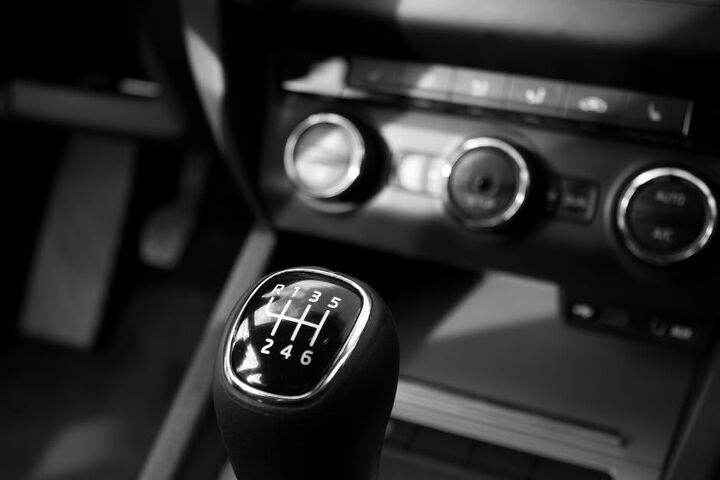Toyota's New Patent Screams 'Regulate the Manuals!'

In this day and age, when a “coupe” often means a four-door SUV and automatics, DCTs, and CVTs perform almost all gear-shifting duties, it’s nice to see a patent from a major mainstream automaker concerning a manual transmission.
However, Toyota’s recent patent for an electronic tranny nanny might spark worry that the three-pedal experience, as endangered as it is, could become watered down by technology. A manual transmission that doesn’t let you make mistakes? Who’s in charge here?
The patent, filed to the U.S. Patent and Trademark Office back in January (and first noticed by Motor1), concerns an electronic control unit for your stick-shift gearbox.
Automated manuals aren’t anything new, but making a manual tranny shift like an automatic isn’t this technology’s intent — at least, not entirely. No, Toyota’s patent fully recognizes the need for a clutch pedal, though the automaker clearly doesn’t trust the person behind the hand on the gearshift.
The controller’s operation seemingly has two functions: eking out better gas mileage by automatically shifting to neutral when the vehicle is coasting, and preventing the driver from acting stupid and potentially damaging the vehicle (or his pride).
It’s a very wordy patent, which you can peruse yourself. The gist, which comes by way of the application’s abstract, sums it up:
An electronic control unit permits a shift operation to a neutral position, by which a manual transmission 14 is switched to neutral, during coasting control. Accordingly, shifting to the neutral position can be performed only by the shift operation. Thus, power transmission can be blocked after termination of the coasting control. In addition, the electronic control unit prohibits the shift operation to a particular gear after the transmission is switched to neutral. Thus, overreving or underreving at the termination of the coasting control can be suppressed.
The patent filing goes on to describe how the car’s new nanny engages the clutch and places the vehicle in neutral to bring engine speeds down during coasting, while preventing the shifting of gears during this coast phase via lock pins. Should someone depress the clutch pedal during this phase, the system cancels and hands transmission management back over to the driver.
What gear the car ends up in following this phase depends on vehicle speed. Regardless, assuming the ECU works, it’ll be the right gear.
That’s because once the ECU terminates the coast phase, the same lock pins prevent the driver from selecting too high or low of a gear — potentially sending the engine past redline or bogging down. More MPGs and less powertrain danger is this invention’s goal.
Still, the question everyone’s asking is, “Why bother?” With clutchless transmissions more prevalent than ever before, why go to the trouble of smoothing out the longstanding drawbacks of the manual tranny? Also, if the ECU’s goal is optimum operation of the gearbox, what gears (especially lower gears) can drivers expect to find off-limits at any given time?
Will Toyota have us all driving Miss Daisy?

More by Steph Willems
Latest Car Reviews
Read moreLatest Product Reviews
Read moreRecent Comments
- Argistat Re the carbon use for "necessary battery mining for all-electric vehicles."... Matt, I assume you're talking about mining to produce the battery. Does anyone know what that carbon number is vs. the carbon use to build and keep refueling an ICE vehicle? Or a hybrid? I don't know the answer.An EV battery can in some cases have a very long life. A close friend has an 8 year old Telsa Model X with 116K miles on the battery, and the battery still has 94% of its original capacity.
- EBFlex Remember child labor is only ok when kids are mining for EVs.
- EBFlex Looks great. Sadly it’s saddled with the wrong powertrain. Needs the 5.7 and 6.4 HEMI
- The Oracle Toyota Corolla, at least 10years old
- Rover Sig Toyota knows a think or two about making cars, and what the market wants.


































Comments
Join the conversation
I think this is intended for a hybrid application. Either a current drivetrain or a future 48v system, doesn't matter. Reasoning. On a combustion only engine this would result in an increase in fuel use, by locking out engine braking which uses less fuel than idling. The only way this improves energy efficiency is if the system has regenerative braking which would convert light braking effort to usable energy for the batteries. The addition of transmission lock outs is foolish however. They run a very real risk of not accounting for all driving styles and conditions in their software setup. I read the note about the clutch deactivating it, which should make Rev matching from the forced neutral possible, but I would still be concerned about the implementation of that. It's literally not a problem that needs solving. The jetty hybrid did this exact same thing, so the interesting part isn't really new, just new to manual transmissions.
My guess is that it is for an automatic braking system with a manual - otherwise if the car would try to stop on its own the car would stall.